
 |
|
|
#1 |
|
All the news that's fit to excerpt
Name: newsie
Location: who knows?
Join Date: Jun 2008 Motorcycle(s): only digital replicas Posts: Too much.
|
[motorcycle.com] - Plugging Away: Stop&Go vs. Dynaplug Tubeless Tire Repair
 Let’s just get the disclaimers out of the way right up front, shall we? No tire manufacturer wants you to plug its tire if you run over a nail, not even a brand new one. Some of them might tell you it’s okay to patch a tire, with a permanent patch glued on from the inside. But that’s not what the plugs here are for: The Stop&Go mushroom-style plug and the Dynaplug pointy-style are here to keep you from having to ride a tow truck to your destination when you pick up a nail en route and don’t have a tire mounting machine at hand. Stop&Go says “Safety experts all agree that a punctured and/or plugged motorcycle tire should be replaced as soon as possible. That is our opinion also.” Dynaplug, interestingly, says its plugs are a permanent fix, as certified by an independent testing outfit called UTAC. UTAC did the testing on a car tire, and refines that the plug is a permanent fix for holes up to the size of a 16-penny nail (about 1/8 -inch or 3mm), at speeds up to 90 mph. Does that apply to motorcycle tires, too, I asked? Dynaplug’s spokesperson says it does. Brave words. 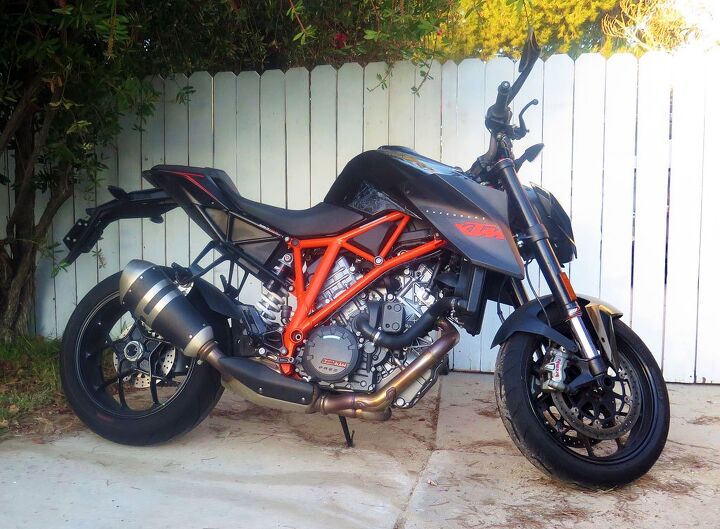 As mentioned last week in our KTM Super Duke R long-term report, that bike’s rear Pirelli picked up a nail 500 or so miles ago, which I plugged with a Stop&Go mushroom style plug kit I had on hand. I could’ve put a new tire on the bike, but it was scheduled to return to KTM HQ sometime in the near future – we just weren’t certain how near – so why bother? I rode other bikes. After a week I noticed the tire hadn’t lost any air. I started riding it again, gently and slowly at first, then faster – all for the sake of science of course. At no time did I exceed about 90 mph on the plugged rear. It’s been six or eight weeks now and 500 miles, no problems. I plugged the rear tire in my R1 once before with the Stop&Go with the same success. Looking for something to write about on a slow news day and googling up other Stop&Go experiences to compare to mine, of course I found that small percentage of people who wouldn’t plug Obama’s golf-cart tire with a Stop&Go in a lightning storm with FDR caddying. All the S&G haters seemed to be big fans of the Dynaplug … a comparo is born! 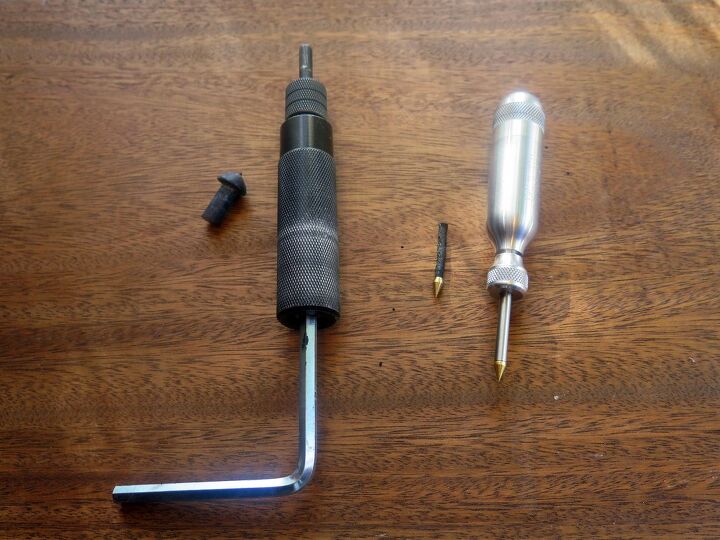 Stop&Go mushroom plug and tool at left (the kit’s bounced around in many motorcycles over the last six or eight years), Dynaplug at right. Stop&Go mushroom plug and tool at left (the kit’s bounced around in many motorcycles over the last six or eight years), Dynaplug at right.The Stop&Go is more complex and impressive to deploy than the Dyna. Basically you’re inserting a big steel syringe into the tire, then using the handle’s internal screw mechanism to squeeze that pre-lubricated mushroom head into the tire with the included hex wrench. Once that’s accomplished, pull out the syringe, yank on the mushroom stem a few times to seat the head inside the casing (there’s no glue involved), trim off the excess, and you’re probably good to go – slowly at first please. A little water or saliva poured on the repair will let you see if air is escaping. It’s a little bit MacGyver. The main complaint people have with the S&G is it needs a pretty big hole: 6.25mm. Most nails and things don’t leave a hole that big, and by the time you remove the object and use the included reamer to make the hole big enough for the tool to fit, you’ve lost all your air. (No worries with my Pocket Tire Plugger Plus CO2 Inflation kit, which comes with four CO2 cartridges I’ve never had to use since all my flats have luckily made themselves known at my dwelling.) 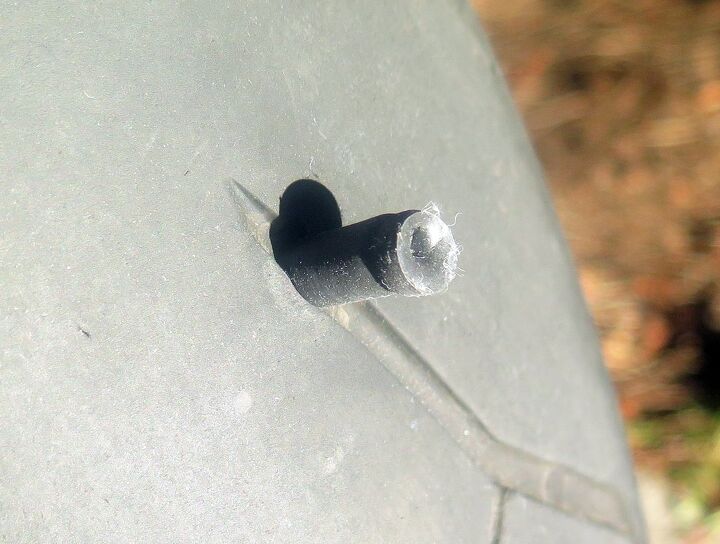 A fresh Stop&Go plug in place. Yank on it to seat the plug, trim the excess and ride on. The stem of the mushroom is 8mm in diameter, and was squeezed into the tire through a syringe with a 5mm inner diameter. Curiously satisfying … A fresh Stop&Go plug in place. Yank on it to seat the plug, trim the excess and ride on. The stem of the mushroom is 8mm in diameter, and was squeezed into the tire through a syringe with a 5mm inner diameter. Curiously satisfying …Intuitively, the S&G feels like a pretty good repair. Deployed inside the tire, the head of that mushroom plug is 14mm in diameter and the stem is 8mm wide, with air pressure and centrifugal force both holding it in place. Stop&Go says what can go wrong, but usually doesn’t, is that the tire flexing can cause the steel belt to slice through the stem. You can tell how the Dynaplug works by looking at it: Load the brass-tipped sticky plug in the handle and jab it in the hole like a jailhouse shiv, then pull it back out: The shoulder on the brass tip and the gooey nature of the plug are both going to hold it in place. As opposed to the 6.25mm hole you need for the S&G, the widest part of the Dynaplug’s brass tip is only 4.6mm. If you load a plug in the handle and have it ready to go, and the nail is still in your tire along with most of its air, you should be able to yank the nail and plug the hole so quick you won’t lose much more air pressure. It’s amazing how hard you have to pound to drive a rusty drywall screw into a worn-out rear Pirelli. When I yanked it back out (you need pliers) and went to shank the tire with the spit-moistened Dynaplug, though, no way was the 4.6mm tool going into the 3mm hole, in spite of its sharp tip, in spite of a few hammer blows. Those steel belts are tough! Dynaplug instructions say never enlarge the hole with a reamer, but there’s a tool included that looks suspiciously like one, which Dynaplug says is a “clearing attachment.” I “cleared” quite a few metal shavings from the puncture with it before I could get the plug in, by which time the tire was totally flat. When I aired it back up and sprayed on a little soapy water, we were still losing air. Dynaplug says feel free to insert up to four plugs (but the UTAC guarantee is only good if you only use one). The gooey goodness of the first plug actually made it pretty easy to shove the second one right into the same hole. Hah! Airtight! 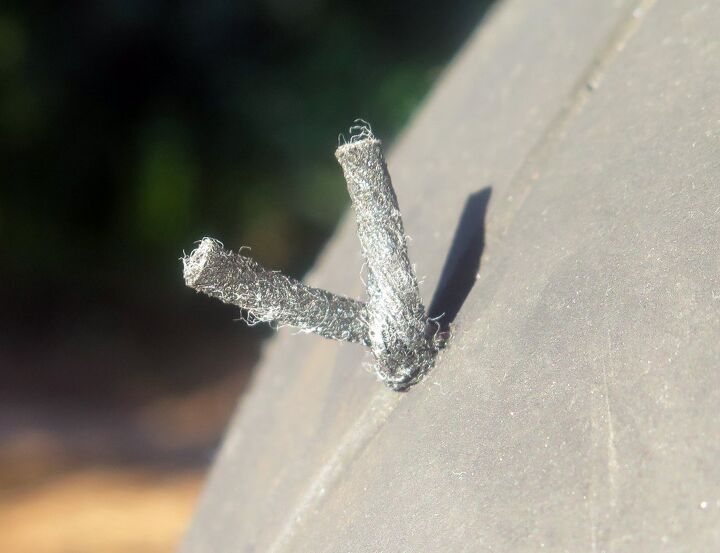 It took two Dynaplugs to seal the hole made by one 3mm drywall screw. Dynaplug says using up to four is okay. Once trimmed and ridden on, it looks like one big happy plug from the outside. It took two Dynaplugs to seal the hole made by one 3mm drywall screw. Dynaplug says using up to four is okay. Once trimmed and ridden on, it looks like one big happy plug from the outside.While I was having fun playing with all of it, I rotated the tire 180 degrees to check out the old Stop&Go plug in the other side with the soapy water treatment. What the? Apparently the deflation had caused it to start leaking. I loaded a fresh mushroom into the tool and shoved it in right on top of the old one. Fixed. Dynaplug says it makes its points from brass specifically because they’ll disintegrate inside the tire should they come loose from the plug, and that they will not damage TPMS sensors. Right, I’ve put another 60 miles on the bike with two Dynaplugs and one Stop&Go plug in the back tire, at speeds up to 90-ish, and haven’t lost a pound of air after one week. We thought about spinning the thing up to speed on the dyno to really test things, but our dyno operator pointed out potential liability concerns and said he’d prefer not to. We don’t want to give anyone the slightest bit of encouragement to ride at high speed on a plugged tire. Experienced motorcyclists have known about simple gooey string tire patches for years, of course. You only have to be stranded once in the middle of nowhere to appreciate how convenient having a flat repair kit on your bike can be. Both the Dynaplug and Stop&Go plugs, to my mind anyway, just add a little extra sense of security. 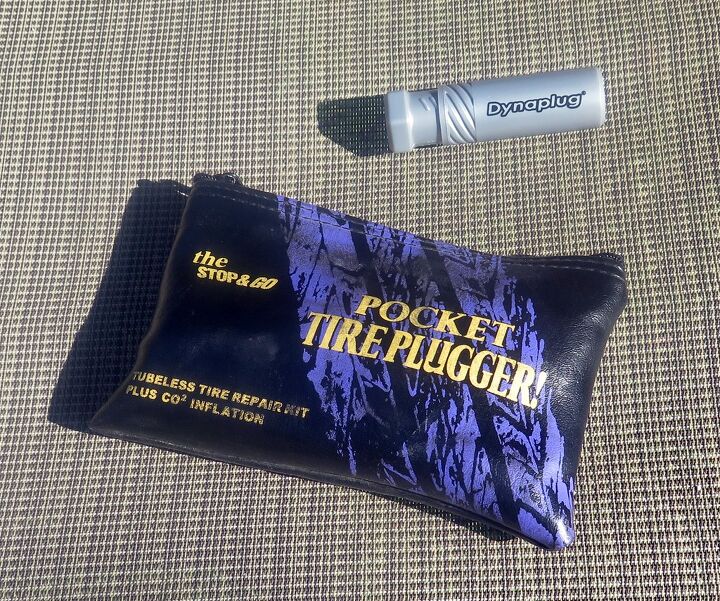 The S&G kit here ($49.95) takes up a bit more room (5 x 7.5 x 1-inch), is more capable of plugging bigger holes, and also has an air source in the form of its CO2 cartridges. The Dynaplug Pro ($59.99 or $29.99 for the new Ultralite) is good too, and super-compact – but you’ll need air if your tire goes all the way down. In any case, most people will tell you: The greatest deterrent to nails and screws is having some kind of repair kit handy. Either of these should keep you rolling. For more information, visit the official Stop&Go or Dynaplug websites. Plugging Away: Stop&Go vs. Dynaplug Tubeless Tire Repair appeared first on Motorcycle.com. Click here for full story...
__________________________________________________
I'm a bot. I don't need no stinkin' signature... |
|
|

|
 |
 Similar Threads
Similar Threads
|
||||
| Thread | Thread Starter | Forum | Replies | Last Post |
| [motorcycle.com] - 2013 AIMExpo: Stop & Go Tire Pluger Video | Ninjette Newsbot | Motorcycling News | 0 | October 22nd, 2013 05:00 PM |
| [hell for leather] - How to patch a tubeless motorcycle tire | Ninjette Newsbot | Motorcycling News | 0 | April 18th, 2013 01:10 PM |
| [webbikeworld.com] - Cargol Turn & Go Flat Tire Repair Tool Review | Ninjette Newsbot | Motorcycling News | 0 | March 27th, 2011 04:30 PM |
| [topix.net] - Gryyp's Cargol Turn & Go Tubeless Tire Repair Kit | Ninjette Newsbot | Motorcycling News | 0 | August 25th, 2010 02:10 AM |
| Plugging a Tubeless Tyre | Sailariel | 2008 - 2012 Ninja 250R Tech Talk | 23 | July 10th, 2009 08:20 PM |
|
|